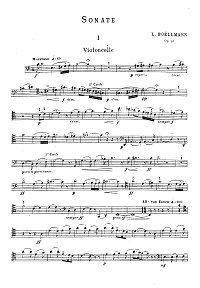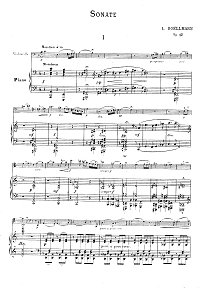Boellmann - Cello sonata A minor op.40
Boellmann - Cello sonata A minor op.40. You can download the PDF sheet music Boellmann - Cello sonata A minor op.40 on this page. Virtuosity and modality are two elements in Boellmann's A minor Cello Sonata. But our first surprise may be the range of minor keys explored by the first movement's introduction, and the variety of almost (but not quite) Wagnerian harmonic sideslips. The flattened seventh is a feature of the main theme, as the long note in the middle of the bar is of the second theme - a favourite device of late nineteenth-century French composers. The development cleverly uses the minor-key explorations of the introduction to new effect.
To download PDF, click the "Download PDF" button below the appropriate sheet music image.
To view the first page of Boellmann - Cello sonata A minor op.40 click the music sheet image. |
| PDF format sheet music |
|
|
|
Instrument part: 14 pages. 2071 K
|
Piano part: 45 pages. 6130 K
|
 |
 |
|
|
| Download PDF (14.99
€) |
Download PDF (14.99
€) |
|
The theme of the slow movement of this cello sonata gives the impression of being about to break into recitative, as the cello's phrases habitually begin with a rest on the first downbeat. This slight uneasiness is calmed in the beautiful central section, which inhabits a Duparc-like dreamworld, before strenuous times return. The occasional harmonic corner suggests that Boellmann had looked at the works of that great master of French organ writing, Caesar Franck. The opening theme of the last cello sonata's movement not only provides further evidence of modal thinking, in an A minor with F sharps and G naturals, but also cunningly shows solidarity with the opening themes of the two previous movements: with the upbeat rhythm of the second movement, and with the triplet motion of the first. A chorale-like passage near the end of the movement subscribes to a familiar pattern in French music (see, for example, the finale of Saint-Saens's Third Violin Concerto), but this is merely a springboard for further rhythmic agitation, and the work ends, not in a triumphant A major, but in an A minor which perhaps reflects those searching minor keys in the introduction. The Valse lente and the Menuet, while scarcely calling for analysis, are finely written and rarely predictable.
Leon Boellmann was one of those who took the risk of not studying at the Paris Conservatoire, but went instead to the Ecole Niedermeyer, founded by Louis Niedermeyer in the middle of the nineteenth century for the training of organists and choirmasters. Like Faure and Messager, he studied under one of the school's most successful alumni, Eugene Gigout but, unlike them, went on to become a virtuoso organist. In 1896, the year before his death at the age of only thirty-five, he was appointed organist of the church of St Vincent de Paul.
As a composer, Boellmann is best known for his Suite gothique for organ, the last movement of which is a fiery Toccata in the pattern which was to continue in the works of Dupre and Messiaen, and probably beyond.
|
|